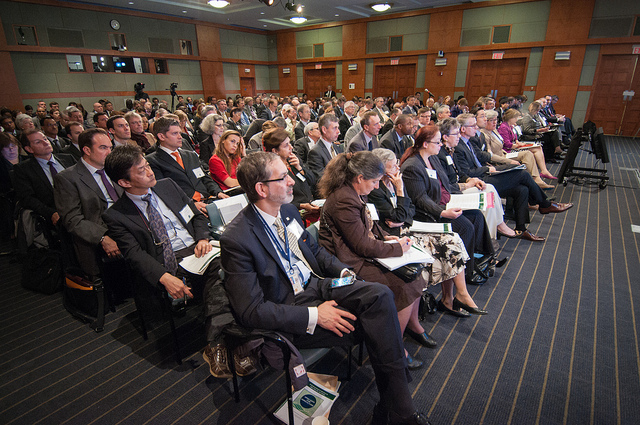
This article is cross-posted on the USDA blog
Last week, hundreds of innovators gathered at the World Bank IFC Center to brainstorm about how Open Data can be harnessed to help meet the challenge of sustainably feeding nine billion people by 2050. The group included delegates from the G-8 group of nations, US Government officials, private sector partners, Open Data advocates, technology experts, and nonprofit leaders – all participants in the first-of-its-kind G-8 International Conference on Open Data for Agriculture.The foundation for such collaboration was set by President Obama’s first ever global development policy which emphasizes broad-based economic growth, innovation, and partnership; and the President’s leadership on food security through the L'Aquila Food Security Initiative and Feed the Future. Then, at the 2012 G-8 Camp David Summit, the G-8 nations, African partners, the private sector and civil society launched the New Alliance for Food Security and Nutrition and committed to host a conference focused on sharing relevant data to help advance agriculture and ensure food security for people around the world. At the end of the year, the White House hosted a Global Development Data Jam—the first high-level U.S. Government event to feature the potential of Open Data to address global challenges.
Last week’s G-8 “Open Ag Data” conference hosted by the USDA, built on this important groundwork by focusing on ways to ensure that Open Data about agriculture are not only available, but also put to good use. It also highlighted some excellent work that’s already underway and making positive change in the Open Ag Data arena, including:
- MFarm has built a mobile application that allows farmers to receive accurate, real-time crop-price information from five major markets in Kenya, via daily text message, six days per week. The service helps farmers to make informed decisions on what to plant when, how to price produce, and where to sell to the largest profit. MFarm is currently refining their service and will soon begin integrating USAID data into their product to help deliver more accurate price information to users.
- INSEAD has introduced Toto Agriculture, a smartphone interface fueled by USAID data that provides village-specific agricultural data. Users can use this free application to access localized information on soil, pests, climate, and planting tips in over 100 languages.
- iPlant: A community driven collaborative of researchers, educators, and students working to enrich all plant sciences through the development of the cyberinfrastructure essential for modern biology. The collaborative can sequence the genome of an individual cow in 3 hours, taking the time of sequencing from months down to hours.
But this is just the beginning. At last week’s conference, USDA, USAID, and a number of other entities—both domestic and international—unleashed a host of new datasets, tools, and platforms—with more to come in the weeks and months ahead. For our part, the U.S. Government:
- Launched The Food, Agriculture, and Rural “data community” on Data.gov, which offers more than 300 datasets (and growing!) that relate to the social, economic, and environmental aspects of agriculture. For example, the new community offers Quick Stats—a comprehensive tool for accessing agricultural data profiles by subject area or commodity, such as crops and plants, or livestock. Over the next few months, USDA will make these data available in a robust Application Programming Interface (API) to enable easier sharing of data by third party applications and services.
- The Millennium Challenge Corporation released an open evaluation data catalog that contains household survey metadata from food security programs in Armenia, El Salvador, Ghana, and the Philippines, and more data is coming soon.
- Launched USAID.gov/Developer, a page that curates APIs and datasets specifically for developers looking to scrub in and work with open global development data. APIs include the U.S. Overseas Loans and Grants, or Greenbook, which encompasses all international aid funding allocations. This data will help developers and researchers more dynamically parse these data, that goes all the way back to the Marshall Plan.
We can’t wait to see what entrepreneurs, nonprofits, researchers, scientists and others around the world do with these new resources, and what exciting innovations emerge. We’re also excited to strengthen our partnership with other countries and the private sector to further liberate data and improve global food security.
The G-8 Open Data for Agriculture Conference was a great start. We look forward to seeing the Open Ag Data movement continue—leveraging data, collaboration, and innovation to accelerate progress toward our food security goals.
There are steps you can take right now to get involved in the Open Ag Data movement:
- Visit the new Food, Agriculture, and Rural data community on Data.gov
- Join the conversation about Open Agriculture Data using the hashtag #OpenAgData on Twitter
- Check out USAID’s new Developer Resource Page
- Read a blog and watch a video from the G-8 Open Agriculture Data conference.
Todd Park is the US Chief Technology Officer
Tom Vilsack is the US Secretary of Agriculture


